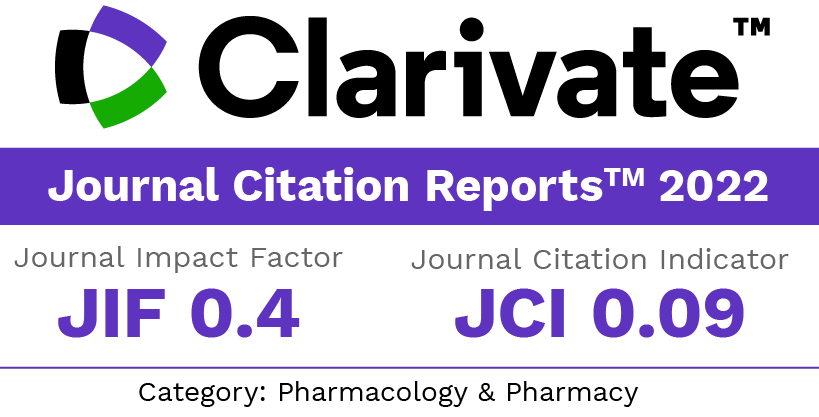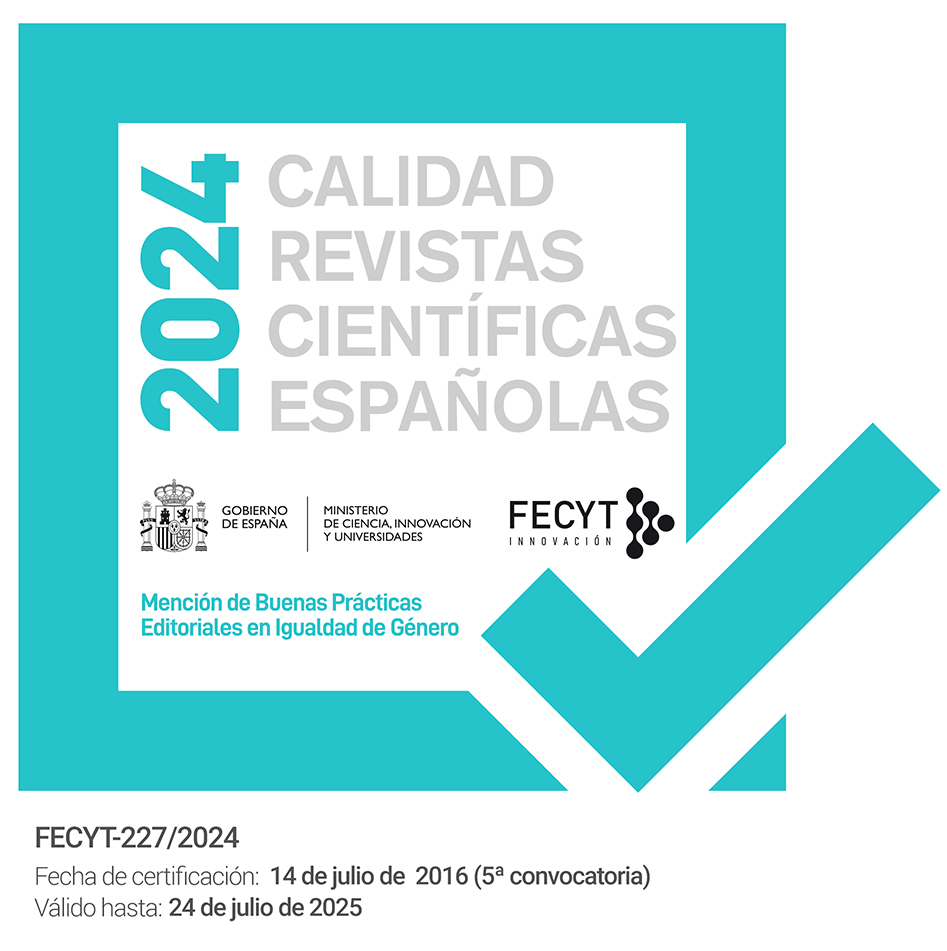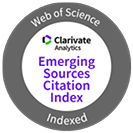Antioxidant activity of alkaloids from Bocconia arborea. A study on six testing methods
Abstract
Antioxidative activity-guided fractionation together with chemical analysis led to the isolation of three benzophenanthridinealkaloids from methanol extract of the bark of Bocconia arborea. Identification was based on spectroscopic methods.The isolated alkaloids 6-acetonyldihydrochelerythrine, chelerythrine and dihydrochelerythrine were tested for antioxidativeactivity on thiocyanate assays, free radical scavenging activity, b-carotene bleaching method, and deoxyribose assay. Allalkaloids exhibited significant antioxidant activities in linoleic acid and b-carotene. Although afforded protection againstthe damage of deoxyribose, liposome peroxidation and microsomial lipid from peroxidation, also exhibited scavengingeffects on the 1,1-diphenyl-2-picrylhydrazyl radicals.Downloads
References
Djerassi C, Connolly JD, Faulkner DJ, Mori K, Nakanishi K, Ourisson G, Raphael RA, Shamma M, Tamm C. Dictionary
of natural Products London: Chapman & Hall; 1994. p.117-124.
Manske RHF, Brossi A, eds. The alkaloids. New York: Wiley; 1985. p.253-286
Harbone JB, Baxter H. (1993). Phytochemical dictionary. A Handbook of bioactive compounds from plants. London:
Taylor & Francis; 1993. p.203.
Roberts MF, Wink M. Alkaloids: biochemistry, ecology and medicinal applications. New York: Polonium Publishing;
p.397-433.
Vavreeckova C, Gawlik I, Muller K. Benzophenanthridine alkaloids of Chelidonium majus; 1.Inhibition of 5- and 12—
lipoxygenase by a non-Redox mechanism. Planta Med 1996; 62: 397-401.
Cuendet M, Hostettmann K, Potterat O. Iridoid glucosides with free radical scavenging properties from Fagrae blumei.
Helv Chim Acta 1997; 80: 1144-1152.
Burits M, Bucar F. Antioxidant activity of Nigella sativa essential oil. Phytother Res 2000; 14: 323-328.
Miller HEA. A simplified method for the evaluation of antioxidant . J Am Oil Chem Soc 1971; 45: 91-98.
Daglia M, Papetti A, Gregotti C, Berte F, Gazzani G. In vitro antioxidant and ex vivo protective activities of green and
roasted coffe. J Agric Food Chem 2000; 48: 1449-1454.
Nakatani N, Kikuzaki H. A new antioxidative glucoside isolated from Oregano (Origanum vulgare L.). Agric Biol
Chem 1987; 51: 2727-2732.
Blois MS. Antioxidant determination by the use of a stable free radical. Nature 1958; 181: 1199-1200.
Yen G, Chang Y, Sheu F, Chiang H. Isolation and characterization of antioxidant compounds from Aspergillus candidus
Broth filtrate. J Agric Food Chem 2001; 49: 1426-1431.
Pellegrini N, Ying M, Rice-Evans C. Screening of dietary carotenoids and carotenoid-rich fruits extract for antioxidant
activities applying 2,2´-azobis(3-ethylbenzothine-6-surfonic acid) radical cation decolorization assay. Methods Enzymol
; 299: 379-389.
Aruoma OI. Assessment of potential prooxidant and antioxidant actions. J Am Oil Chem Soc 1996; 73: 1617-1625.
Halliwell B, Gutteridge MC, Auroma OI. The deoxyribose method: A simple “test-tube” assay for determination of rate
constants for reactions of hydroxyl radicals. Analytical Bioch 1987; 165: 215-219.
Ratty AK, Sunamoto J, Das NP. Interaction of flavonoids with 1,1-diphenyl-2-picrylhydrazyl free radical, liposomal
membranes and soybean lipoxygenase-1. Biochem Pharmacol 1988; 37: 989-995.
Duh PD. Antioxidant activity of burdock (Ardium lappa linne): its scavenging effects on free radical and active oxygen.
J Am Oil Chem Soc 1998; 75: 455-461.
Gazzani HG, Papetti A, Daglia M, Berte F, Gregotti C. Protective activity of water soluble components of some
common diet vegetables on rat liver microsome and the effect of thermal treatment. J Agric Food Chem 1998; 46:
-4127.
Ramos A, Piloto J, Visozo A, Garcia A, Lastra H, Ponce de Leon H. Mutagenicity and antioxidant assessment of
Stachitarpheta jamaicensis (L.) Vahl Phytother Res 2001; 15: 360-363.
Oechslin SM, Konig GM, Merkel KO, Wright AD, Kingghorn AD, Sticher O. An NMR study of four benzophenanthridine
alkaloids. J Nat Prod 1991; 54 : 519-524.
Slavik J, Slavikova L. Alkaloide der monhgewachse (Papaveraceae) II. Trenunung des chelerythins und sanguinarins
und auffindung von zwei neuen alkaloiden im schollkraut (Chelidonium majus L.). Colle Czecho Chem Commun
; 20: 21-26.
Slavik J, Dolejs L, Hanus V, Cross AD. Alkaloids of Papaveraceae XL. Chelirubine, chelilutine, sanguinrubine, and
sanguilutine, mass and nuclear magnetic resonance spectra of benzophenanthridine alkaloids. Colle Czecho Chem
Commun 1968; 33: 1619-1623.
Stermitz FR, Chen L, White JI. Alkaloids of the Papaveraceae. Tetrahedron 1966; 22: 1095-1102.
Sharma PN, Shoeb A, Kapil RS, Popli SP. Toddalidimerine, a dimeric benzophenanthridine alkaloids from Toddalia
asiatica. Phytochemistry 1981; 20: 2781-2783.
MacLean DB, Gracey DEF, Saunders JK, Rodrigo R, Manske RHF. Some benzophenanthridine alkaloids from Bocconia
arborea. Can J Chem 1969; 47: 1951-1956.
Manske RHF. Alkaloid from Bocconia arborea. Can J Res B 1943; 21:140-144.
Hanaoka M, Motonishi T, Mukai C. Chemical transformation of protoberberines. Part 9. A biomimetic synthesis of
oxychelerythrine, dihydrochelerythrine, and chelerythrine from berberine. Chem Soc Perkin Trans 1986; 2253-2256.
Holloway GM, Gainer J. The carotenoids crocetin enhances pulmonary oxygenation. J Appl Physiol 1988; 65: 683-686.
Aruoma OI, Grootveld M, Halliwell B. The role of iron in ascorbate-dependent deoxyribose degradation. Evidence
consistent with a site specific hydroxyl radical generation caused by iron bound to deoxyribose molecule. J Inorganic
Bioch 1987; 29: 289-299.
Halliwell B. How to characterize a biological antioxidant. Free Rad Res Comms 1990; 9: 1-32.
Laughton MJ, Evans PJ, Moroney MA, Hoult JRS, Halliwell B. Inhibition of mammalian 5-lipoxygenase and cyclooxygenase
by flavonoids and phenolic dietary additives. Bioch Pharmacol 1991; 42: 1673-1681.
Horie T, Murayama T, Mishima T, Itoh F, Minamide Y, Fuwa T, Awazu S. Identified diallyl polysulfides from an aged
garlic extract which protects the membranes from lipid proxidation. Planta Med 1989; 55: 506-508.
Plaa GL, Hewitt WR. Toxicology of the liver. In target organ toxicology series. New York: Raven Press: 1982. p.217-
Downloads
Published
How to Cite
Issue
Section
License
The articles, which are published in this journal, are subject to the following terms in relation to the rights of patrimonial or exploitation:
- The authors will keep their copyright and guarantee to the journal the right of first publication of their work, which will be distributed with a Creative Commons BY-NC-SA 4.0 license that allows third parties to reuse the work whenever its author, quote the original source and do not make commercial use of it.
b. The authors may adopt other non-exclusive licensing agreements for the distribution of the published version of the work (e.g., deposit it in an institutional telematic file or publish it in a monographic volume) provided that the original source of its publication is indicated.
c. Authors are allowed and advised to disseminate their work through the Internet (e.g. in institutional repositories or on their website) before and during the submission process, which can produce interesting exchanges and increase citations of the published work. (See The effect of open access).


















